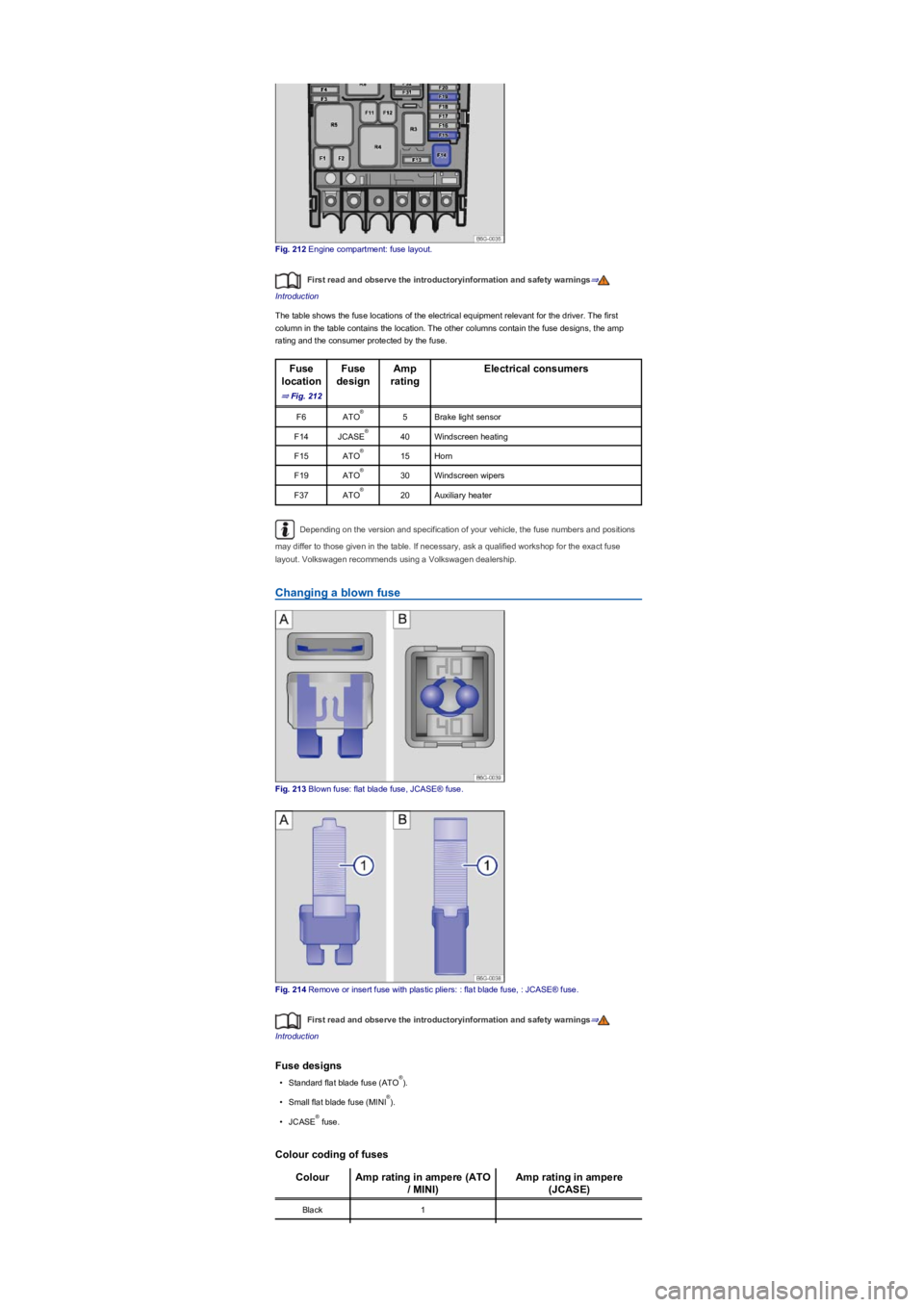Page 262 of 341

Fig. 212 Engine compartment: fuse layout.
First read and observe the introductoryinformation and safety warnings⇒
Introduction
The table shows the fuse locations of the electrical equipment relevant for the driver. The first
column in the table contains the location. The other columns contain the fuse designs, the amp
rating and the consumer protected by the fuse.
Fuse
location
⇒ Fig. 212
Fuse
design
Amp
rating
Electrical consumers
F6ATO5Brake light sensor
F14JCASE40Windscreen heating
F15ATO15Horn
F19ATO30Windscreen wipers
F37ATO20Auxiliary heater
Depending on the version and specification of your vehicle, the fuse numbers and positions
may differ to those given in the table. If necessary, ask a qualified workshop for the exact fuse
layout. Volkswagen recommends using a Volkswagen dealership.
Changing a blown fuse
Fig. 213 Blown fuse: flat blade fuse, JCASE® fuse.
Fig. 214 Remove or insert fuse with plastic pliers: : flat blade fuse, : JCASE® fuse.
First read and observe the introductoryinformation and safety warnings⇒
Introduction
Fuse designs
•Standard flat blade fuse (ATOyf�.
•Small flat blade fuse (MINIyf�.
•JCASE fuse.
Colour coding of fuses
ColourAmp rating in ampere (ATO
/ MINIyf
Amp rating in ampere
(JCASEyf
Black1
®
®
®
®
®
®
®
®
Page 263 of 341

ColourAmp rating in ampere (ATO
/ MINIyf
Amp rating in ampere
(JCASEyf
Orange5
Brown7,5
Red1050
Blue1520
Yellow2060
White or clear25
pink3030
Green3040
Light green40
pink3030
Preparation
•Switch off the ignition, the lights and all electrical consumers.
•Open the appropriate fuse box ⇒ Fuses in the dash panel.
Detecting a blown fuse
•Shine a torch onto the fuse. This will help you to spot the blown fuse more easily.
•If a flat blade fuse (ATO, MINIyf has blown, this can be recognised from the top and side
through the transparent housing by the fact that the metal strip has melted ⇒ Fig. 213.
•If a JCASE fuse is blown, the melted metal strip can be seen from the top through the
transparent housing ⇒ Fig. 213.
Changing a fuse
•If applicable, take the plastic pliers ⇒ Fig. 214① out of the fuse box cover.
•Push the plastic pliers suitable to the fuse design ⇒ Fig. 214① or ⇒ Fig. 214① onto
the fuse from the side.
•Remove the fuse
•If the fuse has blown, replace it with a new fuse of the same amp rating (same colour and same
markingsyf���D�Q�G� same size ⇒.
•Once the new fuse is inserted, put the plastic pliers back in the cover.
•Fit the fuse box cover.
Jump starting
Introduction
This chapter contains information on the followingsubjects:
⇒ Jump lead connection point (earth connectionyf
⇒ Jump lead connection point (positive terminalyf
⇒ Jump starting the vehicle
If the engine fails to start because the 12-volt vehicle battery is flat, the discharged battery can be
connected to the 12-volt battery of another vehicle to start the engine.
Suitable jump leads are needed for jump starting. The wire cross section must be at least 25 mm
for petrol engines and at least 35 mm for diesel engines.
®®
®
You can damage another position in the electrical system by using a fuse with a higher
amp rating.
NOTICE
2
2
Page 264 of 341

Jump lead connection point (earth connectionyf
Fig. 215 In the engine compartment: jump start connection point (earth connectionyf�.
First read and observe the introductoryinformation and safety warnings⇒
Introduction
There is a jump lead connection point (earth connectionyf���L�Q���W�K�H���H�Q�J�L�Q�H���F�R�P�S�D�U�W�P�H�Q�W���I�R�U���F�R�Q�Q�H�F�W�L�Q�J�
the black jump lead ⇒ Fig. 215㊀.
The vehicle can be jump-started or be used to jump-start another vehicle only via this jump lead
connection point.
Jump lead connection point (positive terminalyf
Fig. 216 In the engine compartment underneath a cover: jump lead connection point (positive
terminalyf�.
Using the jump leads incorrectly or completing the jump start procedure incorrectly can
cause the 12-volt vehicle battery to explode, which can lead to severe injuries. Please
observe the following in order to reduce the risk of the 12-volt vehicle battery exploding:
•All work on the 12-volt vehicle battery and the electrical system can cause serious
chemical burns, fire or electric shocks. Always read the warnings and safety
information before carrying out any kind of work on the 12-volt vehicle battery ⇒ 12-
volt vehicle battery.
•The vehicle battery providing assistance must have the same voltage as the flat vehicle
battery (12 voltsyf���D�Q�G���D�S�S�U�R�[�L�P�D�W�H�O�\���W�K�H���V�D�P�H���F�D�S�D�F�L�W�\�����V�H�H���O�D�E�H�O���R�Q���E�D�W�W�H�U�\�\f.
•Never charge a 12-volt vehicle battery that is frozen or that has thawed. Discharged 12-
volt vehicle batteries can already freeze at temperatures of around 0°C (+32°Fyf�.
•The 12-volt vehicle battery should be replaced if it is frozen or has thawed.
•A highly explosive mixture of gases is given off when the 12-volt vehicle battery is
jump started. Always keep fire, sparks, naked flames and lit cigarettes away from the
12-volt vehicle battery. Never use a mobile telephone when the jump leads are being
connected or disconnected.
•Position the jump leads so that they never come into contact with any moving parts in
the engine compartment.
•Never confuse the negative and positive terminals or connect the jump leads
incorrectly.
•Observe the jump lead manufacturer's instructions.
WARNING
Please note the following in order to avoid considerable damage to the vehicle electrical
system:
•A short circuit can be caused if the jump leads are wrongly connected.
•The vehicles must not touch each other, as any contact could mean that electricity
could flow as soon as the positive terminals are connected.
NOTICE